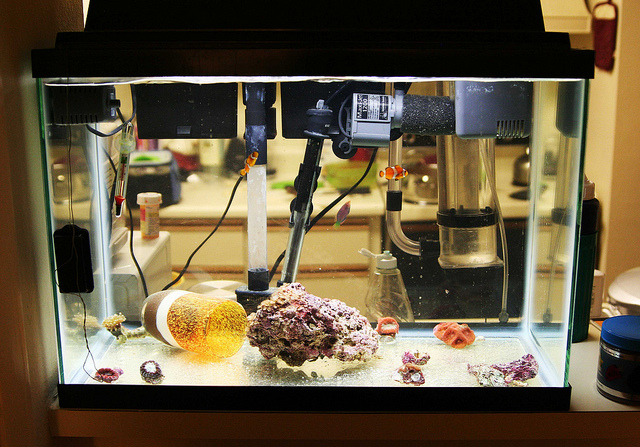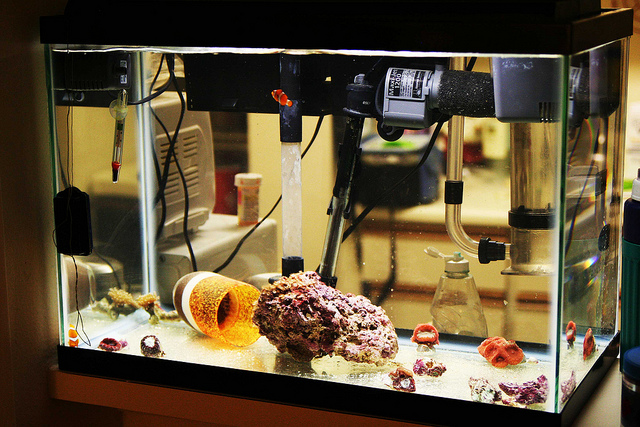That QT looks a little large. how many gallons is it?
dosing meds and water changes can get pricey.
75g each.Dissadvanges could be costs. But allows me to QT more/larger fish simataniously
Follow along with the video below to see how to install our site as a web app on your home screen.
Note: This feature may not be available in some browsers.
That QT looks a little large. how many gallons is it?
dosing meds and water changes can get pricey.
Here's my quarantine tank:
Front:

Three-Quarter view:

As you can tell, it's currently in use. Here is my method of implementing the QT.
I've got a 55g display and a 20gal QT. My 50gal display was originally a kit with light hoods, power filter, etc. Much of it I didn't want or need for my tank, so it worked out nicely as I can use it in my QT. Also some failed ideas for the main tank end up on the QT, even if they aren't particularly useful for it (notice the magnet scrubber on the left). This also includes the almost useless seaclone skimmer. It actually works quite well for the QT for a few reasons... one thing is it adds to the o2 levels, it gives some circulation, and most QT's don't have a skimmer so I don't really expect it to do its job (though would be happy if it did). Also, I'm using on it the bubble trap for my Coralife 65 skimmer to keep it from crapping bubbles all in the tank. It has about a 90% reduction in bubbles (but for the seaclone, 10% of its bubbles getting through is still a major issue which is why it's off in the pics).
I've got my QT for numerous reasons, but before I get into why I'd like to explain quickly how I do it. I find that in speaking with most people it's their execution of a QT that makes it unsuccessful.
It's amazing how many people put fish into a QT without any type of biological filtration. This boggles my mind, most of these same people fully understand the cycling of a tank, they somehow have forgotten that this applies to ALL new tanks! What I do for biological filtration is I have a filter which has "bio pads" in it or some dumb name like that. Basically they are just plastic bio media. I keep these in between the baffles of my sump during QT not being used time. The reason is, if you don't keep an active source of ammonia coming into the tank, the good bacteria will die, causing a cycle again when the bio load changes. People tend to think of a tank's cycle as a one time deal but actually it's a continual process that gets modified constantly, especially when there are changes to the tank like more fish being added, things dying, fish being taken away, etc. People just need to keep this in mind when working with QT's as they are no different.
The second key to my success is the water due to acclimation. People use QT's for acclimation purposes, that's not what I'm referring to. When a fish gets ill, the absolute last thing you want to do to this poor fish is throw him quickly into water with totally different chemistry. Hypothetically, if there was a problem in the tank's water that needed corrected, EVEN THEN you want THAT water in your QT. The way I achieve this is when I do any water changes at all, I always begin at the QT, no exceptions. I take as much as needed to be changed out of my QT, then I take the water from my DT and put it into buckets and put that water into the QT. This is not only cost effective, but also is great practice because when done properly keeps transferring from one tank to the other as stress free as possible.
The third key to success is keeping in mind the different reasons for the tank. Mine is used for 3 things, acclimation, treatment, and a safe haven. In order to meet all of these needs, I really can't use a substrate. The primary reason being, it may trap some chemicals, and most importantly could leach those out at a later time, harming whatever is in the tank. Finally, another important thing to remember is what to put in there when. If the tank isn't being used some basic decorations can chill in there, but keep your live rock out of it and your bio filtration out as well. It would be a good idea to get some cheap bio-media alternatives (ie pot scrubbers, shower puffs, shredded plastic, anything that's plastic, has no metals, and plenty of surface area) and place those in the sump. If the QT needs to be used for treatment, only add disposable bio media, then throw it out once you're finished curing the fish of whatever ails it. This will ensure cross contamination of harmful chemicals to your main tank wont occur.
I have my QT for many reasons. I've not had to deal with sick fish yet, but I'm always ready should the need ever arise. Right now, the fish and numerous corals are in there because the main tank is going through a major cyano bacteria war. The lights have been off, there have been chemicals added, etc. While I could have probably done this just as easily without removing the fish, the beauty of having an always ready QT is that I have that option should I choose to be safe and QT the fish. In the least, it will allow me to "fatten them up" a bit and feed them a bit more freely while battling the algae in the other tank, so that I don't have to decide between feeding the fish or fighting the algae.
In the end, the major points I'm really trying to convey are:
- Always fill your QT with water from your main tank
- Always have active biological media ready for your QT
- Keep your QT ready for action, never want to be caught off guard as with any illness (human or fish), a quick diagnosis and aggressive treatment can mean the difference between life and death
- Be careful about cross contamination or getting the chemicals in any live rock or the QT. I recommend against using any substrate.
Well, that's my 2 cents worth, or 20 dollars worth lol. Sorry for the lengthy reply. Hope this helps! It's very sad to see when people improperly execute quarantine tanks. They usually are "too little too late" and the fish end up not making it. I personally know someone who stopped doing salt water tanks all together because they had a bad outbreak of ich and decided to purchase a quarantine tank and throw it all together then put the fish in it. The tank wasn't cycled, and the ich was pretty far advanced. This combination couldn't have had a happy ending no matter how you slice it.
The numbers of "good" bacteria will decrease if there is less/no food supply. I like to "ghost" feed the tank a bit and dose with Seachem Stability during fallow periods.Thanks so much for the detailed and thoughtful walk-through. I had two specific questions for you:
1) My 105g DT recently completed its cycle and my 20g long QT is currently cycling (kicking myself for not starting them at the same time). You mentioned that the good bacteria "die" if there is not a source of ammonia and you will need to start the cycle all over again. I was under the impression that the bacteria were always present in a cycled tank, but that you should never introduce too much bioload at once because the bacteria need time to multiply to reach the appropriate level to convert ammonia-->nitrite-->nitrate. So my DT is currently sitting completely fallow while I'm waiting on my QT to cycle, and then I'll need to quarantine my first clowns, so I'm probably looking at 1 1/2 months before anything get introduced to my DT. Are you saying that all of the good bacteria will die and I will need to begin my cycle from scratch? If so, I'm going to start introducing an artificial ammonia source.
2) Because I'm on the front end of introducing fish to my DT, I will likely be using my QT over and over for the next several months. For example, as soon as my QT cycles, I'll quarantine two clowns for 3-4 weeks (will use Cupramine, PraziPro and hyposalinity), and then transfer them to the DT. And then will introduce another fish or two into the QT (maybe a lawnmower blenny, engineer goby, anthias, etc.) and start the process all over again. And then maybe next comes a couple of small tangs. And so on. I currently have a HOB filter and a small powerhead running. In the HOB filter, I have a mesh sock of Matrix rocks (which are very porous and provide the majority of my biological filtration--kind of like small chunks of marine pure). Is there an issue with keeping those rocks in my QT full time to keep the biological filtration during this QT heavy use period if I never take them out?
The numbers of "good" bacteria will decrease if there is less/no food supply. I like to "ghost" feed the tank a bit and dose with Seachem Stability during fallow periods.
Consider adding a bubble filter to the QT and a small powerhead aimed up at the surface to increase O2 exchange. Soak the bubble filter's foam pad with the "Stability" or similar product like BioSpira. I leave a mesh bag of Matrix or BioMax in my sump 24/7 seeding them so they are ready when needed. Also keep a foam pad for HOB and foam pad for bubble filter in there too. They all need to soak for at least 30 days or so. Or I soak them all overnight in Stability, but prefer the sump soak.
I usually leave the bag of media in the HOB after fish have been treated unless I used copper. I toss the media if so. So I'm always "seeding" a new bag of media, filter pads in my DT sump.
Seems like the little micro passage ways in the media can get clogged up and I've had the media develop a thick layer of green slime, especially back when I was using large Marine Pure plates 8"x 8"
So it's just easier for me to toss the old after copper and not have to worry.
Are you using a Hanna HL Copper Checker to monitor/dose copper? Great product and lowers your stress and the fish's.
When dosing Cupramine, ignore the directions on the bottle. Those two large doses can be very harsh on some fish. Instead actually measure your QT for its volume. Tanks are never the size they say they are + the volume of your HOB. Then calculate the total number of drops needed to reach therapeutic which is 0.50 for Cupramine. Spread out the drops over 4-5 days, and even longer with copper sensitive fish to 5-7 days.
Cupramine is an interesting product. The dose is very low and the therapeutic range is correspondingly narrow. Think it got a bad rap as it is very easy to under and over-dose it. But the Hanna has changed that. Spreading out the doses also gives you the opportunity to "see" the occasional copper sensitive fish before too much damage is done. Copper is after all a poison.
Do you have a Seachem Ammonia Alert badge to monitor for ammonia build up? It works with Cupramine. You cannot use Prime or other ammonia reducers with Cupramine. It makes the copper more toxic. Ironically you can use Prime with "chelated" coppers like Copper Power, Coppersafe.
I primarily use Copper Power. It's a chelated copper and can be used safely with a wider variety of fish. Come fish don't do well with "ionic copper" like Cupramine. But I do use Cupramine. It's more widely available.I do have an Ammonia Alert badge in my QT--great product. Do you use Cupramine, or one of these other products?
Are there certain types of fish that you would say do not do well with ionic copper? Or did you mean it's more hit or miss when it comes to any random fish tolerating ionic copper?I primarily use Copper Power. It's a chelated copper and can be used safely with a wider variety of fish. Come fish don't do well with "ionic copper" like Cupramine. But I do use Cupramine. It's more widely available.
Here you go. . .Are there certain types of fish that you would say do not do well with ionic copper? Or did you mean it's more hit or miss when it comes to any random fish tolerating ionic copper?

 www.reef2reef.com
www.reef2reef.com
Hey i Just want to say thank you for sharing your input even though it's your message is 10 years old. I still find it very helpful.Great news! Firstly, don't be discouraged by many experiences you'll read or hear about, horror story wise. Unfortunately many QT's are inadequate and set up in a rush, providing little hope for the new fish. Remember that the main reasons for QT are also overlooked... they should be used to acclimate fish to captivity including eating prepared foods, getting used to being around people, and also checking for any illnesses that can easily be treated for in QT. We are literally throwing new fish into battle with our existing, established fish that know when, what and how we feed, easily outcompeting even boisterous newcomers. QT period gives them a chance... we need to stop the "dump and hope" approach!
There are really two types of QT tanks you'll see, I like to label one as an "Acclimation QT" and the other as a "Hospital QT", although I run both in oneAcclimation QT's will house live sand and live rock, generally with some algae growth on them for (certain) new fish to pick at, along with the hiding cover provided by the LR. They're generally used to get fish acclimated to captivity and taking prepared foods. Hospital QT's are generally bare bottom tanks with some PVC, eggcrate, other inert materials used for hiding (generally thought to not "suck up" as much meds). They're generally used to dose medications once they've been through the "acclimation" phase. Either needs to be equiped with a biological filter, many people use HOB or sponge filters (I prefer HOB, easy to maintain and can easily run carbon), a heater (preferably on a controller for redundancy) and in certain cases supplemental flow for oxygentaion (I rely on the HOB filter).
The MAIN killer in QT is Ammonia, particularly tanks that are run bare bottom with no llive rock. In those tanks WE literally are the filter, keeping a close eye on ammonia levels and doing water changes as necessary. Be prepared to do 100% water changes (if necessary) on QT at all times just in case.
Many people only run one or the other mentioned QT tanks, but really should be running both, or both in one as I do. Copper is a med often used in the QT stage that will be absorbed by LR and LS, and is a main reason people run the "hospital" style tank. I've seen (along with many others) that while using Seachem Cupramine, not only is it a very gentle copper med compared to others, it is not absorbed as much as other medications. After the first day of dosing it stabilizes fairly easy.
Make sure to have up to date test kits and meds while using either, and it's good to have beneficial vitamins, garlic enhancers, etc. on hand for the newcomers. I always have a Seachem "Ammo Alert" badge in the QT tank that tells me when Ammonia gets to an unsafe level.. They're cheap, effective, and last a year - I rarely if ever test for Ammonia in my QT anymore.
Don't plumb a QT tank into you main system, it defeats part of it's purpose in that pathogens get passed onto your existing animals. I use a simple shop light over the tank to grow algae on the rocks. If you plan to house coral in it you need more light of course, but then you cannot run copper in it either. If you QT fish and coral you really ought to run two seperate QT's... coral QT's can be very small.
Here's a pic of my QT (eggcrate top is put to use when fish are in the tank):

When all is said and done I also highly recommend a "social acclimation" period in which new fish are placed in an acrylic box (or similar) inside the display while letting Spaophold Jylland the existing inhabitants see them and get used to their presence.
